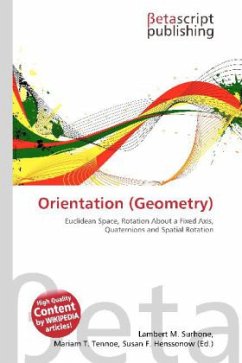
Orientation (Geometry)
Versandkostenfrei!
Versandfertig in 6-10 Tagen
23,99 €
inkl. MwSt.

PAYBACK Punkte
12 °P sammeln!
Please note that the content of this book primarily consists of articles available from Wikipedia or other free sources online. In geometry the orientation or attitude of a body is a description of how it is aligned to the space it is in. The orientation is given relative to a frame of reference, usually specified by a Cartesian coordinate system, by giving the rotation that would move the body from a base or starting orientation to its current orientation. This is similar to the body''s location which can be given by a translation relative to a base position. The position and orientation toge...
Please note that the content of this book primarily consists of articles available from Wikipedia or other free sources online. In geometry the orientation or attitude of a body is a description of how it is aligned to the space it is in. The orientation is given relative to a frame of reference, usually specified by a Cartesian coordinate system, by giving the rotation that would move the body from a base or starting orientation to its current orientation. This is similar to the body''s location which can be given by a translation relative to a base position. The position and orientation together describe how the body is placed in space. Euler''s rotation theorem shows that every orientation is equivalent to a single rotation about a fixed axis. This gives one common way of representing the orientation using an axis angle representation. Other popular methods include as a rotation quaternion, using Euler angles or a rotation matrix, all of which are widely used today. More specialist uses include aircraft principal axes in flight Miller indices in crystallography, strike and dip in geology and grade on maps and signs.












